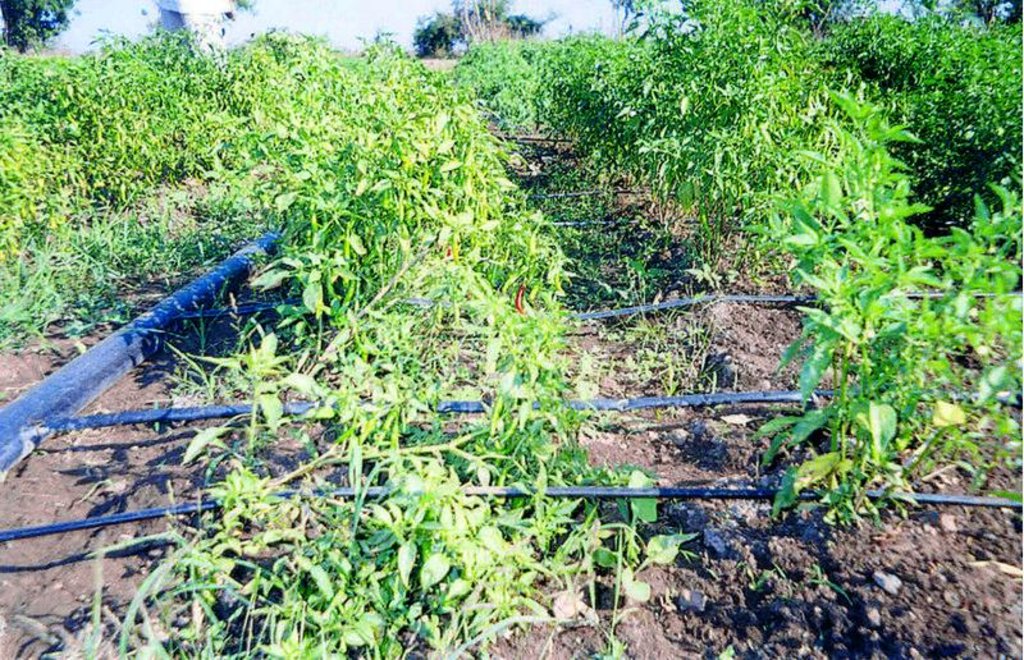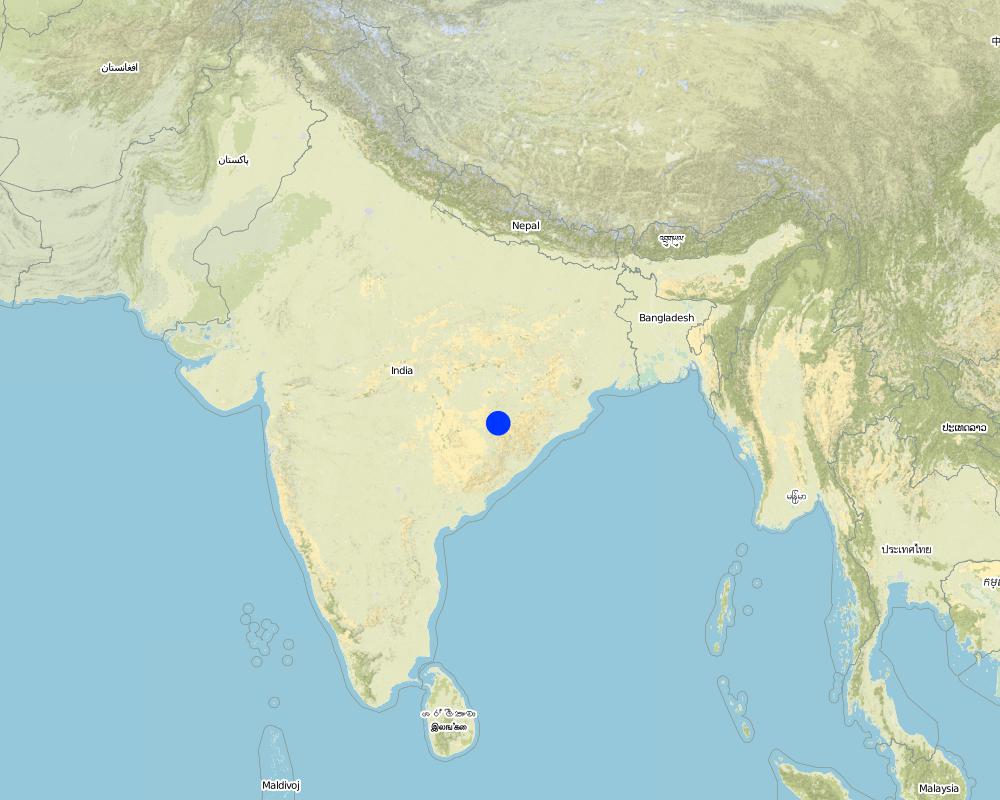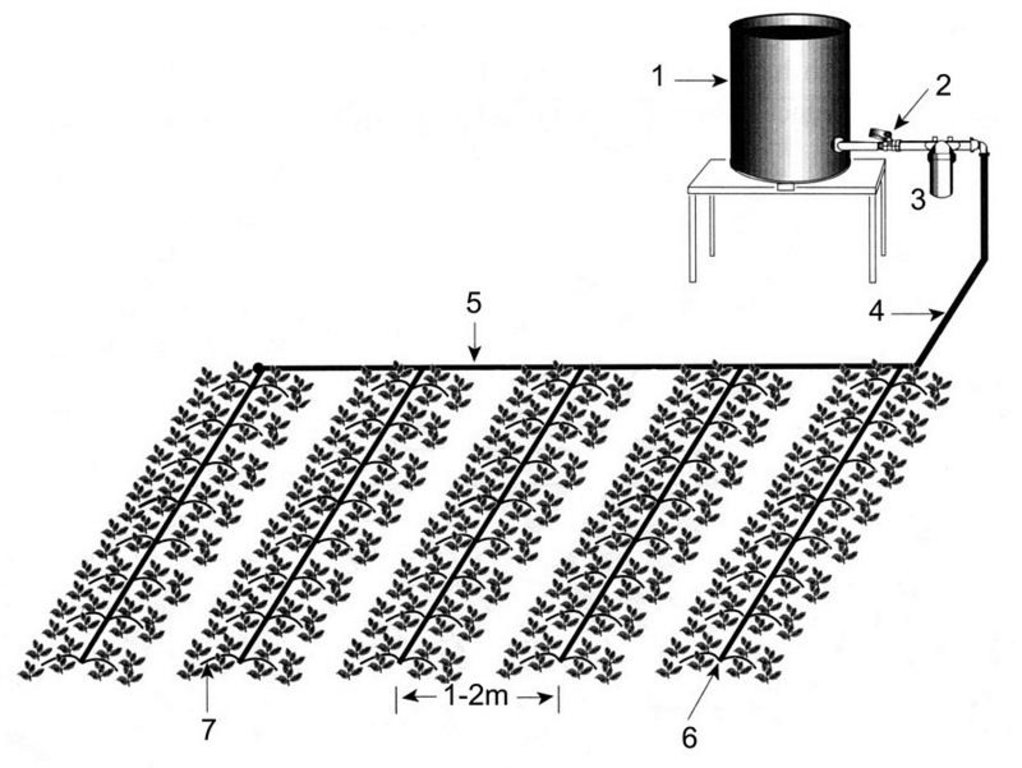Pepsee micro-irrigation system [India]
- Creation:
- Update:
- Compiler: Shilp Verma
- Editor: –
- Reviewers: Fabian Ottiger, Alexandra Gavilano
Pepsee
technologies_1477 - India
View sections
Expand all Collapse all1. General information
1.2 Contact details of resource persons and institutions involved in the assessment and documentation of the Technology
SLM specialist:
Sadagani Amitabha
International Development Enterprises
India
Name of project which facilitated the documentation/ evaluation of the Technology (if relevant)
Book project: where the land is greener - Case Studies and Analysis of Soil and Water Conservation Initiatives Worldwide (where the land is greener)Name of the institution(s) which facilitated the documentation/ evaluation of the Technology (if relevant)
IWMI International Water Management Institute (IWMI) - IndiaName of the institution(s) which facilitated the documentation/ evaluation of the Technology (if relevant)
International Development Enterprises - India (iDE-India) - United States1.3 Conditions regarding the use of data documented through WOCAT
The compiler and key resource person(s) accept the conditions regarding the use of data documented through WOCAT:
Yes
1.5 Reference to Questionnaire(s) on SLM Approaches (documented using WOCAT)

Market support and branding for input quality (Krishak … [India]
Market development and support through use of a brand name - Krishak Bandhu ('the farmer's friend') - to help ensure quality amongst manufacturers and suppliers of drip irrigation equipment.
- Compiler: Shilp Verma
2. Description of the SLM Technology
2.1 Short description of the Technology
Definition of the Technology:
A grassroots innovation that offers most of the advantages of conventional micro-irrigation at a much lower establishment cost.
2.2 Detailed description of the Technology
Description:
The continued expansion of irrigation in India is causing increasing water shortages. This may be compounded by the potential effects of climate change. Drip irrigation - delivering small amounts of water directly to the plants through pipes - is a technology that could help farmers deal with water constraints. It is considerably more efficient in terms of water use than the usual open furrows or flood irrigation.
In West Nimar, Madhya Pradesh, droughts, diminishing groundwater, limited and erratic power supply coupled with poverty, compelled farmers to look for a technology that would enable them to irrigate their crops (mainly cotton) within these constraints. They tried out several cost-saving options such as using old bicycle tubes instead of the conventional drip irrigation pipes. But nothing caught on - until about five years ago - when a local farmer experimented with thin poly-tubing normally used for frozen fruit-flavoured ‘lollypops’ called pepsee. It spread to neighbouring cotton farmers, and its popularity has meant that today pepsee has become widespread in the region. Pepsee micro-irrigation systems slowly and regularly apply water directly to the root zone of plants through a network of economically designed plastic pipes and low-discharge emitters.
Technically speaking pepsee systems use low density polythene (65-130 microns) tubes which are locally assembled. Being a low pressure system the water source can be an overhead tank or a manually operated water pump to lift water from a shallow water table.
Such a system costs less than US$ 40 per hectare for establishment. But the tubes have a short life span of one (or two) year(s); an equivalent standard buried strip drip irrigation system amounts to between five and ten times the initial cost. The latter would, however, last for five to ten years. The critical factor is the low entry cost. Pepsee systems thus act as ‘stepping stones’ for poor farmers who are facing water stress but are short of capital and cannot afford to risk relatively large investment in a technology which is new to them, and whose returns are uncertain. The technology is today available in two variants: the original white pepsee and a recently introduced black pepsee which is of slightly better quality.
Recently, a more durable and standardised version of pepsee, given the brand name ‘Easy Drip’, has been developed and promoted by a local NGO, IDEI (see corresponding approach). Easy Drip is one product within a set of affordable micro-irrigation technologies (AMIT) promoted by IDEI.
2.3 Photos of the Technology
2.5 Country/ region/ locations where the Technology has been applied and which are covered by this assessment
Country:
India
Region/ State/ Province:
Madhya Pradesh
Further specification of location:
West Nimar
Map
×2.7 Introduction of the Technology
Specify how the Technology was introduced:
- through projects/ external interventions
3. Classification of the SLM Technology
3.1 Main purpose(s) of the Technology
- improve production
- create beneficial economic impact
3.2 Current land use type(s) where the Technology is applied

Cropland
- Annual cropping
Annual cropping - Specify crops:
- fibre crops - cotton
Number of growing seasons per year:
- 2
Specify:
Longest growing period in days: 150 Longest growing period from month to month: May - Oct Second longest growing period in days: 120 Second longest growing period from month to month: Nov - Mar
Comments:
Major land use problems (compiler’s opinion): Acute groundwater stress associated with lowering of the groundwater table limits water for irrigation, coupled with poverty and reluctance to risk investing in relatively expensive- but efficient - drip irrigation systems.
3.4 Water supply
Water supply for the land on which the Technology is applied:
- full irrigation
3.5 SLM group to which the Technology belongs
- irrigation management (incl. water supply, drainage)
3.6 SLM measures comprising the Technology

structural measures

management measures
Comments:
Main measures: structural measures, management measures
3.7 Main types of land degradation addressed by the Technology

water degradation
- Hq: decline of groundwater quality
Comments:
Main type of degradation addressed: Hq: decline of groundwater quality
Main causes of degradation: deforestation / removal of natural vegetation (incl. forest fires), other human induced causes (specify) (agricultural causes), education, access to knowledge and support services (lack of knowledge)
Secondary causes of degradation: over-exploitation of vegetation for domestic use, overgrazing, droughts, land tenure (land subdivision), Land alienation
3.8 Prevention, reduction, or restoration of land degradation
Specify the goal of the Technology with regard to land degradation:
- reduce land degradation
4. Technical specifications, implementation activities, inputs, and costs
4.1 Technical drawing of the Technology
Technical specifications (related to technical drawing):
Components of pepsee/‘Easy Drip’ irrigation systems are described below.
1) Water source: For pepsee, commonly a water pump (in most cases electric) is used to lift water from a well and directly feed the irrigation system.
Alternatively, an overhead tank (minimum of 1 m above ground level) can be used for smaller systems up to 400 m2 area.
2) Control valve: valve made of plastic or metal to regulate pressure and flow of water into the system
3) Filter: Strainer filter to ensure that clean water enters into the system (optional in pepsee systems).
4) Mainline: 50 mm PVC (Polyvinyl chloride) or PE (Polyethylene) pipe to convey water from source to the sub-main.
5) Sub-main: PVC/PE pipe to supply water to the lateral pipes which are connected to the sub-main at regular intervals.
6) Lateral: PE pipes along the rows of the crops on which emitters are connected directly. Pipe size is 12–16 mm.
7) Emitters/micro-tubes: Device through which water is emitted at the root zone of the plant with required discharge. In pepsee farmers simply make pin holes in the plastic tube for water to pass. Easy Drip has inbuilt drippers/outlets along the lateral line which give a continuous wetting strip.
It is mainly used for row crops.
Pepsee uses cheap, recycled plastic tubes instead of the rubber pipes used in conventional drip irrigation kits. Space between emitters is variable, for cotton cultivation it is commonly 1.2 m (between plants, within and between rows). There is (usually) one emitter for each plant. Different sizes of valves, mainlines, etc, are available, depending on flow rate of water in the system. Additional components are joints (connectors) and pegs (used to hold the lateral and micro-pipes in place).
Technical knowledge required for land users: moderate
Main technical functions: water supply, improved water-use efficiency (reduced loss, well directed, selective - and targeted irrigation
Secondary technical functions: improvement of ground cover, higher - germination and establishment rate
Structural measure: irrigation infrastructure
Construction material (other): poly-tubes - low density polythene (65-130 microns)
Change of land use practices / intensity level: from furrow to drip irrigation
Author:
Sijali IV 2001, Drip irrigation, RELMA, Nairobi
4.3 Establishment activities
| Activity | Timing (season) | |
|---|---|---|
| 1. | Installation of water pump, control valve, filter (optional) and PVC piping(main/sub-main and lateral pipes). | dry season |
4.4 Costs and inputs needed for establishment
| Specify input | Unit | Quantity | Costs per Unit | Total costs per input | % of costs borne by land users | |
|---|---|---|---|---|---|---|
| Labour | Labour | ha | 1.0 | 4.0 | 4.0 | 100.0 |
| Construction material | Lateral piping (Pepsee tube) | ha | 1.0 | 17.0 | 17.0 | 100.0 |
| Construction material | Main/sub-main PVC piping | ha | 1.0 | 34.0 | 34.0 | 100.0 |
| Construction material | Other parts (valves, joints et | ha | 1.0 | 40.0 | 40.0 | 100.0 |
| Total costs for establishment of the Technology | 95.0 | |||||
| Total costs for establishment of the Technology in USD | 95.0 | |||||
Comments:
Duration of establishment phase: 1 month(s)
4.5 Maintenance/ recurrent activities
| Activity | Timing/ frequency | |
|---|---|---|
| 1. | Re-installation of lateral pepsee tubes | dry season/ (every 1–2 years). |
4.6 Costs and inputs needed for maintenance/ recurrent activities (per year)
| Specify input | Unit | Quantity | Costs per Unit | Total costs per input | % of costs borne by land users | |
|---|---|---|---|---|---|---|
| Labour | Labour | ha | 1.0 | 4.0 | 4.0 | 100.0 |
| Construction material | Lateral piping (Pepsee tube) | ha | 1.0 | 17.0 | 17.0 | 100.0 |
| Total costs for maintenance of the Technology | 21.0 | |||||
| Total costs for maintenance of the Technology in USD | 21.0 | |||||
5. Natural and human environment
5.1 Climate
Annual rainfall
- < 250 mm
- 251-500 mm
- 501-750 mm
- 751-1,000 mm
- 1,001-1,500 mm
- 1,501-2,000 mm
- 2,001-3,000 mm
- 3,001-4,000 mm
- > 4,000 mm
Agro-climatic zone
- semi-arid
5.2 Topography
Slopes on average:
- flat (0-2%)
- gentle (3-5%)
- moderate (6-10%)
- rolling (11-15%)
- hilly (16-30%)
- steep (31-60%)
- very steep (>60%)
Landforms:
- plateau/plains
- ridges
- mountain slopes
- hill slopes
- footslopes
- valley floors
Altitudinal zone:
- 0-100 m a.s.l.
- 101-500 m a.s.l.
- 501-1,000 m a.s.l.
- 1,001-1,500 m a.s.l.
- 1,501-2,000 m a.s.l.
- 2,001-2,500 m a.s.l.
- 2,501-3,000 m a.s.l.
- 3,001-4,000 m a.s.l.
- > 4,000 m a.s.l.
5.3 Soils
Soil depth on average:
- very shallow (0-20 cm)
- shallow (21-50 cm)
- moderately deep (51-80 cm)
- deep (81-120 cm)
- very deep (> 120 cm)
Soil texture (topsoil):
- fine/ heavy (clay)
Topsoil organic matter:
- medium (1-3%)
If available, attach full soil description or specify the available information, e.g. soil type, soil PH/ acidity, Cation Exchange Capacity, nitrogen, salinity etc.
Soil texture: Fine/heavy (black cotton soil; mostly vertisols, partly inceptisols and entisols)
Soil drainage/infiltration: Poor
5.6 Characteristics of land users applying the Technology
Market orientation of production system:
- commercial/ market
Off-farm income:
- less than 10% of all income
5.7 Average area of land used by land users applying the Technology
- < 0.5 ha
- 0.5-1 ha
- 1-2 ha
- 2-5 ha
- 5-15 ha
- 15-50 ha
- 50-100 ha
- 100-500 ha
- 500-1,000 ha
- 1,000-10,000 ha
- > 10,000 ha
5.8 Land ownership, land use rights, and water use rights
Land ownership:
- individual, titled
Land use rights:
- individual
6. Impacts and concluding statements
6.1 On-site impacts the Technology has shown
Socio-economic impacts
Production
crop production
production area
Comments/ specify:
More land brought under irrigation. This is seen as a negative aspect
Income and costs
workload
Other socio-economic impacts
irrigated area
Comments/ specify:
Greater irrigated area with same amount of water
Socio-cultural impacts
land use/ water rights
Comments/ specify:
More farmers able to irrigate their land
situation of socially and economically disadvantaged groups
Comments/ specify:
Poverty reduction
Social acceptance
Comments/ specify:
Drip irrigation confers the image of a progressive farmer
Ecological impacts
Other ecological impacts
Water use efficiency
6.4 Cost-benefit analysis
How do the benefits compare with the establishment costs (from land users’ perspective)?
Short-term returns:
positive
Long-term returns:
positive
How do the benefits compare with the maintenance/ recurrent costs (from land users' perspective)?
Short-term returns:
positive
Long-term returns:
positive
6.5 Adoption of the Technology
Of all those who have adopted the Technology, how many did so spontaneously, i.e. without receiving any material incentives/ payments?
- 91-100%
Comments:
100% of land user families have adopted the Technology without any external material support
There is a moderate trend towards spontaneous adoption of the Technology
Comments on adoption trend: No detailed information available regarding spread - though this is estimated to be several thousand farmers within West Nimar. All adoption has been spontaneous, without incentives, and the group which has adopted best comprises those who were previously using furrow irrigation. A large number of pepsee adopters are the resource poor farmers but rich farmers have also adopted pepsee.
6.7 Strengths/ advantages/ opportunities of the Technology
| Strengths/ advantages/ opportunities in the compiler’s or other key resource person’s view |
|---|
|
Low initial investment and recurrent costs: risk in adopting new system limited How can they be sustained / enhanced? Keep costs of new variations of pepsee low. |
|
There are significant benefits in terms of reduced water use per unit of land, and in terms of yield per unit land area as well. |
| Few extra skills required to implement and operate the system. |
|
An eventual shift to conventional drip system is feasible: pepsee acts as a ’stepping stone’ How can they be sustained / enhanced? Promote improved drip systems where pepsee has taken off. |
|
Higher yields, better quality, higher germination rate, lower incidence of pest attack; facilitates pre-monsoon sowing. |
6.8 Weaknesses/ disadvantages/ risks of the Technology and ways of overcoming them
| Weaknesses/ disadvantages/ risks in the compiler’s or other key resource person’s view | How can they be overcome? |
|---|---|
|
Pepsee is based on drip pipes which have a limited life: delicate and cannot withstand high pressure |
Develop/use stronger piping materials such as ‘Easy Drip’. |
|
The increased water use efficiency has allowed an expansion in the area irrigated – which has used up the water ‘saved’. |
Develop/use stronger piping materials such as ‘Easy Drip’. |
|
Pepsee systems require replacement of lateral pipes each year and thus incur recurrent input and labour costs |
7. References and links
7.1 Methods/ sources of information
7.2 References to available publications
Title, author, year, ISBN:
Verma S, Tsephal S. and Jose T: Pepsee Systems: grassroots innovation under groundwater stress. Water Policy, 6,pp. 303–318.. 2004.
Title, author, year, ISBN:
http://www.iwaponline.com/wp/00604/wp006040303.htm
Links and modules
Expand all Collapse allLinks

Market support and branding for input quality (Krishak … [India]
Market development and support through use of a brand name - Krishak Bandhu ('the farmer's friend') - to help ensure quality amongst manufacturers and suppliers of drip irrigation equipment.
- Compiler: Shilp Verma
Modules
No modules





